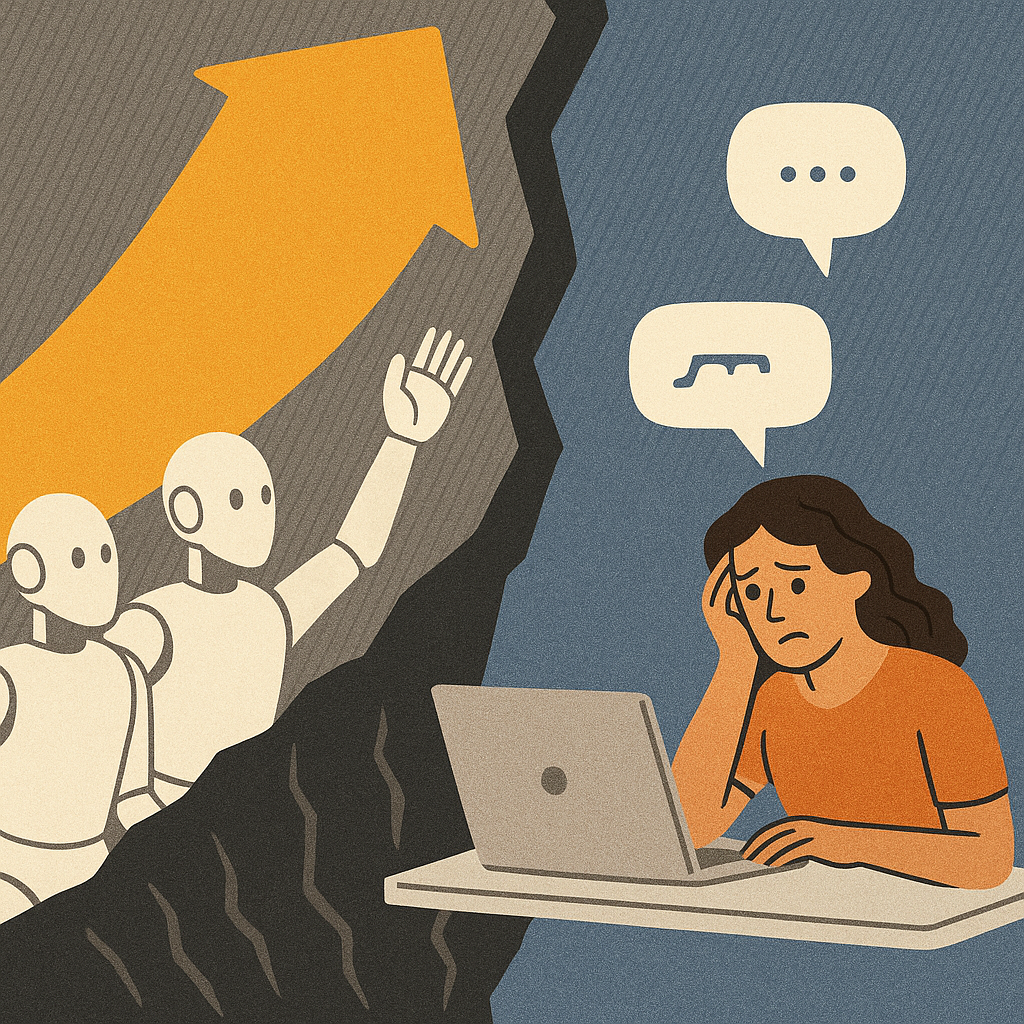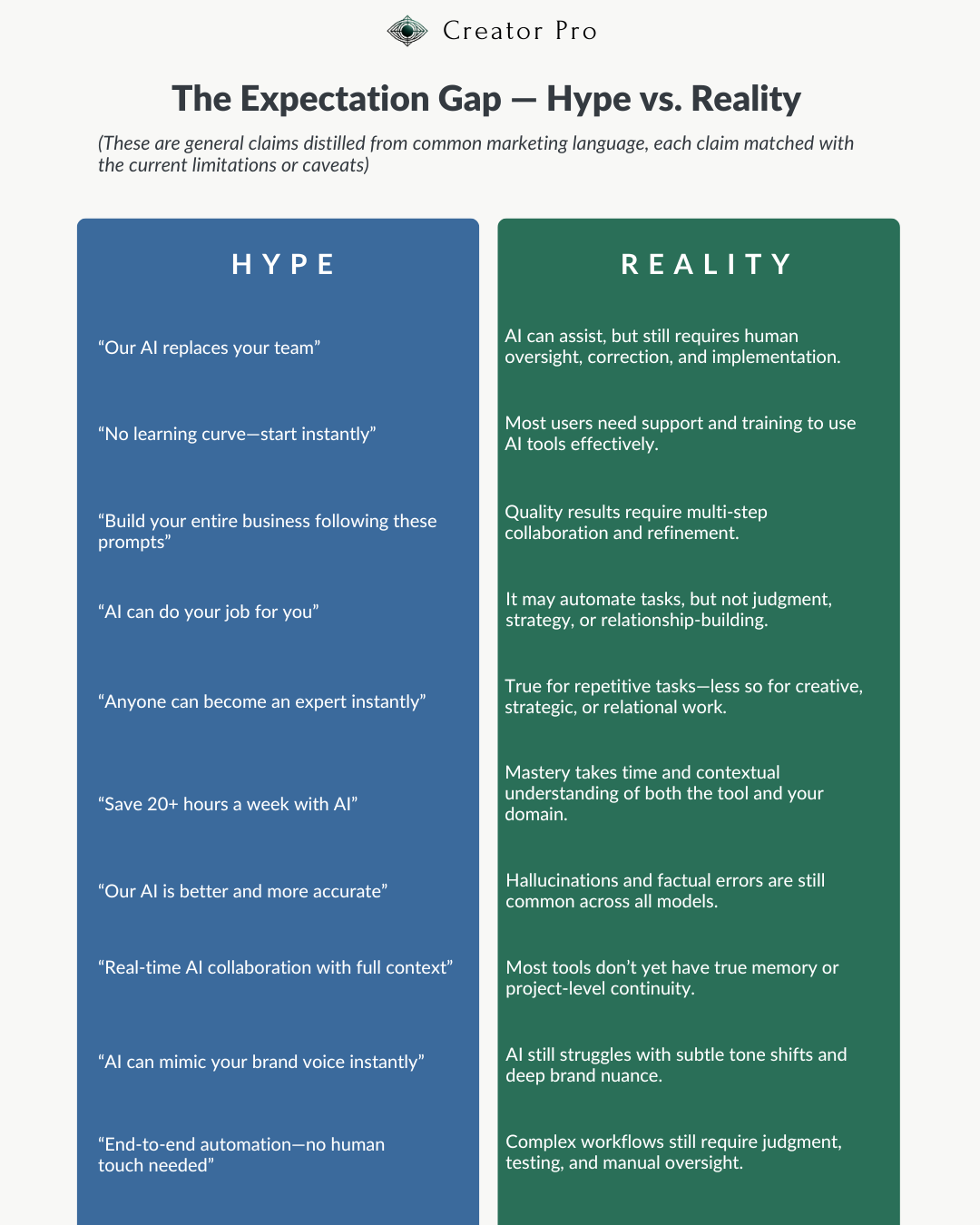Overpromised, Underdelivered

Why AI Expectations Are Out of Control
You’ve seen the headlines: AI is revolutionizing marketing, copywriting, analysis, customer service—entire workflows, all at once. The hype is everywhere, and the pressure to “catch up” is mounting across every industry.
But when professionals open up tools like ChatGPT for the first time, the experience doesn’t always match the promise. What’s being advertised as plug-and-play often feels more like trial-and-error. Some results are impressive, others are underwhelming, and it’s rarely clear why.
This disconnect between what people expect AI to do and what it can reliably deliver today is what we call the AI expectation gap. And as it grows, so does confusion, frustration, and a quiet drop-off in real-world adoption.
What Is the AI Expectation Gap?
The AI expectation gap refers to the mismatch between marketing promises and practical outcomes. It’s not a matter of whether AI is “good” or “bad.” It’s about clarity—what AI is capable of now, what it isn’t, and how much time and human input is actually required to get useful results.
This gap shows up when:
- You see headlines promising 10x productivity with “just one prompt”…
- But your actual experience involves five rephrased prompts, two error messages, and copy you still need to rewrite yourself.
It’s not just frustrating—it undermines confidence, slows adoption, and widens the divide between tech insiders and everyone else.
What’s Driving the Gap?
1. Oversimplified Marketing: From social media to keynote stages, AI is often sold as effortless: “Just type what you want.” “Build your funnel in 30 seconds.” “Write your book in a weekend.”
But real-world usage is different. Even basic outputs often require clear thinking, context, and multiple rounds of refinement. That’s not failure—that’s the nature of collaboration. But it’s rarely described that way.
2. Lack of Onboarding: Most tools assume that an “intuitive interface” is enough. But many users don’t know:
- What the model actually can or can’t do
- What kind of inputs lead to better results
- When something’s gone wrong vs. when it’s a user issue
This leads to trial-and-error use. And for many, eventual burnout.
3. Silent Model Updates: One of the more subtle contributors to the expectation gap is silent feature updates.
OpenAI, for example, has made major changes between GPT-4 and GPT-4.5 without clear communication. Differences in tone, memory behavior, and reasoning ability appear overnight, and unless you’re deeply immersed in online forums, you wouldn’t know why.
This lack of transparency:
- Erodes trust
- Makes learning AI feel like chasing a moving target
- Leads users to doubt themselves instead of the product
When people feel they’re constantly re-learning how a tool works, it’s hard to feel confident—or commit to long-term use.
4. Poor Context Around Limitations: AI tools are powerful, but they’re not all-knowing. They hallucinate facts. They can’t make decisions. They don’t understand context unless you give it to them.
Most marketing glosses over this. As a result, users try to use AI like a magic wand—only to be frustrated when it delivers generic, inaccurate, or outdated information.
Why This Matters
AI adoption isn’t just a tech trend. It’s becoming a core competency for modern work. But when the tools are mis-marketed and under-explained, three things happen:
- People disengage early. They try once or twice, get bad results, and conclude that AI “doesn’t work for them.”
- The learning curve becomes demoralizing. Without context, users can’t tell if the issue is with the model, their input, or a missing feature.
- AI becomes siloed. It’s used only by the most technical or the most persistent, which limits its broader impact across organizations and industries.
The consequence? Slower adoption. Wasted investment. And a growing mistrust of a technology that could otherwise offer enormous value.
Bridging the Gap Starts With Transparency
The fix isn’t more hype. It’s clearer guidance and realistic framing:
- AI is a collaborator, not a shortcut.
- Good results come from better inputs—and some trial and error.
- Context matters. So does structure. So does follow-through.
For teams and leaders investing in AI, the goal shouldn’t be instant transformation. It should be reliable, scalable integration—with expectations set accordingly.
Conclusion
The expectation gap isn’t about technical limitations. It’s about the widening disconnect between how AI is sold and how it’s actually used—and how little support exists to bridge that gap.
When features roll out silently, when capabilities are exaggerated, and when onboarding is left to guesswork, professionals don’t feel empowered—they feel lost. And that loss of trust is far more damaging to adoption than any missing feature.
If we want AI to become truly useful, its rollout must be grounded in clear communication, honest framing, and practical support—not hype. That’s the path toward meaningful adoption, and it starts with telling the truth about what AI can and can’t do.
